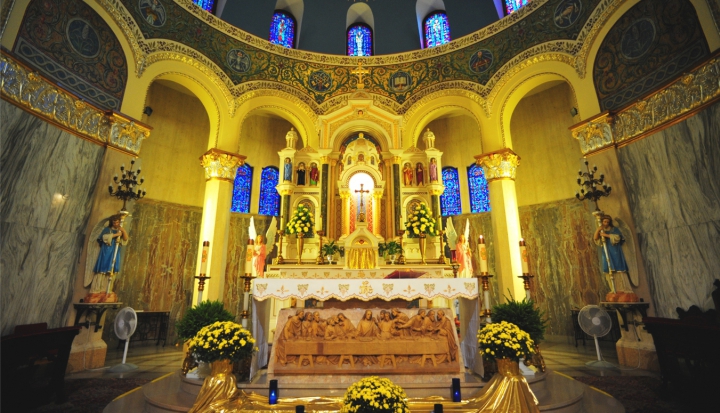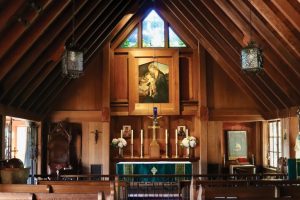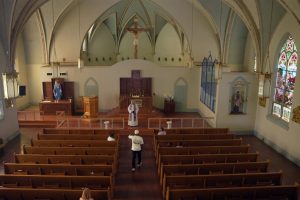Parish Name: Saint Hyacinth Catholic Church
Location: Detroit, Michigan
Founded: 1907
Diocese: Archdiocese of Detroit
Pastor: Reverend Father Janusz Iwan
Number of Parishioners: 300
Parish website: www.sainthyacinth.com
What makes your parish different from other parishes?
Saint Hyacinth Parish has a rich history, dedicated to the love of God and our Polish heritage. Our parish was created by Polish immigrants that settled in this area. Many arrived in America unable to speak the language, not understanding American customs, with little money and no jobs. They faced an uncertain future in these new and unfamiliar surroundings. What they brought with them was their Polish heritage, their desires, their hopes, and most importantly, their faith in God. Our ancestors combined these traits to build a new home and community for themselves in the area known as Poletown. With their strong Catholic background and faith in God, they built new churches in which to practice their religion, including in our beloved parish of Saint Hyacinth. Our parish has withstood the test of time and survived despite the remarkable socio-economic changes and general decline of the area around us. We are now celebrating our 107th year of ministry. This is largely due to the dedication and support of our parishioners, mixed with our Polish pride and love of America. We continue to try and emulate the parish slogan initiated by our former pastor Reverend Francis Skalski: Service to God, America, and Polonia.
What’s the most distinguishing characteristic of your church building?
The parish founders, architects, and Parish Council took much care in deciding upon the structural architecture, paint color schemes, and decorations of the Saint Hyacinth church building. The design and decoration of the building itself includes many symbols of our Catholic faith and Polish heritage. Examples of the symbolic features are described in the below paragraphs:
Above the main altar, there is a composite of mosaics that make a golden band around the sanctuary with a great medallion directly above the altar. The mosaic and great medallion represent the seven sacraments: Water flowing over a shell represents baptism; A dove and tongues of fire to represent confirmation; Keys, representing the power of forgiveness to open the door of heaven through the sacrament of penance; Candles, a Bible, and an hour glass represent extreme unction, or the anointing of the sick; A chalice, host, and priestly stole represent the sacrament of holy orders; Joined hands, stole, and light streaming down from the heavens represent the sacrament of matrimony. The great medallion is placed front and high where it is easily the center of focus. This is because it represents the sacrament of the Holy Eucharist which is the center point of our Catholic faith. The great medallion contains an altar table upon which the chalice and host are shown below the crucifix. This symbolizes the core belief that the Christ’s sacrifice is renewed each time the Mass is celebrated.
There are three domed areas or cupolas. These three rings represent the Holy Trinity. Each of the cupolas is dedicated to a different theme. The first cupola is dedicated to the doctors of the church and include Saints Jerome, Ambrose, Augustine, and John Chrysostom. The middle cupola is dedicated to Polish saints and include Saints Hyacinth, Stanislaus, Cunegunda, Casimir, Stanislaus Kostka, Adalbert, Hedwig, and Josaphat. The last cupola contains figures from the Old Testament: Moses, Abraham, Jeremiah, and Isaiah.
There are 12 pillars supporting the roof representing 12 apostles. A painting of each apostle is located at the juncture where the columns meet the ceiling. The four closest to the altar were reserved for the authors of the gospels: Matthew, Mark, Luke, and John.
The staines glass windows on the lower level portray major events in the life of Jesus Christ. As you go around the church you will see the annunciation, the birth of Christ, finding Jesus in the Temple, Jesus welcoming the children, Palm Sunday, Gethsemane, the agony in the garden, Pilate condemning Jesus to death, the crucifixion, and finally the Risen Christ on Easter.
Later additions to the church include a mural in celebration of the 300th anniversary of Detroit. The mural was painted by a locally famous Polish artist Dennis Orlowski. The mural includes a number of depictions representing our Polish heritage and faith. Included in the mural are paintings of the original six Poletown parishes, Saint John Paul II, and two popular Polish customs, Swięcónka (Blessing of the Easter Baskets) and the Wigilia (Christmas Eve Vigil).
Who is your most interesting parishioner, and what makes them so interesting?
It is difficult to identify a particular person as most interesting. Rather, we look to our seniors as our most interesting asset. Our seniors are true representatives of our Catholic faith and excellent examples of the family atmosphere that the parish has enjoyed. They are also excellent examples of what dedicated parishioners are. Although some in their 70s and 80s, they still display being young at heart, and are found as volunteers at parish events, church cleanings, and through their participation at other parish functions.
What’s the most popular event, ministry, or holiday tradition at your parish?
Saint Hyacinth maintains many of the Polish customs associated with holidays and holy days. One unique and popular event that has become a tradition at Saint Hyacinth and Detroit-area Polonia is the annual Blessing of the Polish American Dance Ensembles. The Blessing Mass is a day of recognition and thanks for their dedication in perpetuating the Polish heritage. The dancers practice and perform all year long, so this is a day for them to relax, be recognized by the Polish community, and receive God’s blessings. The Mass is also intended to provide a venue for the young dancers to see others, young and young at heart, who share their desire to promote our heritage. Each year the Mass includes a different theme to highlight a part of our heritage. This serves as a means to teach the young that attended a little bit of our rich heritage. Each dance school also participates in the offertory which consists of gifts symbolic of our Polish heritage and customs. The Mass has been well accepted by the area dance groups, with 150 to 200 dancers attending the annual event. The dancers come adorned in a wide variety of authentic costumes from various regions of Poland making the assemblage of dancers a truly beautiful and colorful site to see.
If we asked parishioners what they love most about the parish, what would they say?
The feeling they are at home when they come to Mass or other events at Saint Hyacinth. Even though we are not all blood relatives, many of our parishioners have bloodlines that extend back to the early years of Saint Hyacinth. This familiarity brings us closer in our shared experiences—and gives us the grounds to open our arms to welcome new faces.
To see a list of all previously featured parishes, click here.
Image: Main image by Wade Bryant












Add comment